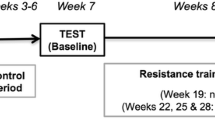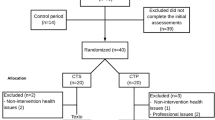Abstract
Background
While it is accepted that resistance training can improve functional capacity in older individuals, the neuromuscular source of this improvement has yet to be identified.
Aim
This study investigated the link between improved neuromuscular performance and functional capacity after a 12-week resistance training period in untrained healthy older individuals.
Methods
Fifteen older men and women (60–71 years) adhered to a 4-week control period, followed by 12 weeks of non-linear resistance training for the lower limbs. Maximum dynamic leg press strength (1-RM), maximum isometric knee extension torque and rate of torque development (RTD) were evaluated at − 4, 0, 4, 8, and 12 weeks, and muscle activity was assessed at 0, 4, 8, and 12 weeks. Functional capacity tests (chair rise, stair ascent and descent, and timed up and go) were performed at − 4, 0, and 12 weeks.
Results
No changes occurred during the control period, but the group increased their 1-RM strength (from 142 ± 53 to 198 ± 43 kg, p = 0.001), which was accompanied by an increase in vastus lateralis activation (p = 0.008) during the intervention. Increase was observed at all RTD time intervals at week 8 (p < 0.05). Significant improvements in all the functional capacity tests were observed at week 12 (p < 0.05).
Discussion
Despite the expected increase in strength, RTD, muscle activity, and functional capacity, there was no significant relationship between the changes in neuromuscular performance and functional capacity. While resistance training elicits various positive improvements in healthy older individuals, actual strength gain did not influence the gain in functional capacity.
Conclusion
The present study highlights the exact cause that improved the functional capabilities during resistance training are currently unknown.



Similar content being viewed by others
References
Häkkinen K, Kallinen M, Izquierdo M et al (1998) Changes in agonist-antagonist EMG, muscle CSA, and force during strength training in middle-aged and older people. J Appl Physiol 84:1341–1349
Viana JU, Silva SLA, Torres JL et al (2013) Influence of sarcopenia and functionality indicators on the frailty profile of community-dwelling elderly subjects: a cross-sectional study. Braz J Phys Ther 17:373–381. https://doi.org/10.1590/S1413-35552012005000102
Aragão FA, Karamanidis K, Vaz et al (2011) Mini-trampoline exercise related to mechanisms of dynamic stability improves the ability to regain balance in elderly. J Electromyogr Kinesiol 21:512–518. https://doi.org/10.1016/j.jelekin.2011.01.003
Rubenstein LZ (2006) Falls in older people: epidemiology, risk factors and strategies for prevention. Age Ageing 35:ii37–ii41
Doherty TJ (2003) Invited review: aging and sarcopenia. J Appl Physiol 95:1717–1727
Frischknecht R (1998) Effect of training on muscle strength and motor function in the elderly. Reprod Nutr Dev 38:167–174
Henwood TR, Riek S, Taaffe DR (2008) Strength versus muscle power-specific resistance training in community-dwelling older adults. J Gerontol A Biol Sci Med Sci 63:83–91
Bohannon RW (1997) Comfortable and maximum walking speed of adults aged 20–79 years: reference values and determinants. Age Ageing 26:15–19
Wilhelm EN, Rech A, Minozzo F et al (2014) Relationship between quadriceps femoris echo intensity, muscle power, and functional capacity of older men. Age (Dordr) 36:9625. https://doi.org/10.1007/s11357-014-9625-4
Henwood TR, Taaffe DR (2005) Improved physical performance in older adults undertaking a short-term programme of high-velocity resistance training. Gerontology 51:108–115
Pinto RS, Correa CS, Radaelli R et al (2013) Short-term strength training improves muscle quality and functional capacity of elderly women. Age (Dordr) 36:365–372. https://doi.org/10.1007/s11357-013-9567-2
Harridge SD, Bottinelli R, Canepari M et al (1996) Whole-muscle and single-fibre contractile properties and myosin heavy chain isoforms in humans. Eur J Physiol 432:913–920, 1996
Aagaard P, Simonsen EB, Andersen JL et al (2002) Increased rate of force development and neural drive of human skeletal muscle following resistance training. J App Physiol 93:1318–1326
Foldvari M, Clark M, Laviolette LC et al (2000) Association of muscle power with functional status in community-dwelling elderly women. J Gerontol A Biol Sci Med Sci 55:M192–M199
Guralnik JM, Ferrucci L, Pieper CF et al (2000) Lower extremity function and subsequent disability: consistency across studies, predictive models, and value of gait speed alone compared with the short physical performance battery. J Gerontol A Biol Sci Med Sci 55:M221–M231
Rantanen T, Avlund K, Suominen H et al (2002) Muscle strength as a predictor of onset of ADL dependence in people aged 75 years. Aging Clin Exp Res 14:10–15
Santos L, Ribeiro AS, Schoenfeld BJ et al (2017) The improvement in walking speed induced by resistance training is associated with increased muscular strength but not skeletal muscle mass in older women. Eur J Sport Sci 9:1–7. https://doi.org/10.1080/17461391.2016.1273394
Leenders M, Verdijk LB, van der Hoeven L et al (2013) Elderly men and women benefit equally from prolonged resistance-type exercise training. J Gerontol A Biol Sci Med Sci 68:769–779. https://doi.org/10.1093/gerona/gls241
Rhea MR, Phillips WT, Burkett LN et al (2002) A comparison of linear and daily undulating periodized programs with equated volume and intensity for local muscular endurance. J Strength Cond Res 17:82–87
Poliquin C (1998) FOOTBALL: five steps to increasing the effectiveness of your strength training program. Strength Cond J 10:34
Siri WE (1961) Body composition from fluid spaces and density: analysis of methods. Nutrition 9:480–492
Tran ZV, Weltman A (1988) Predicting body composition of men from girth measurements. Hum Biol 60:167–175
Brown LE, Weir JP (2001) ASEP procedures recommendations: Accurate assessment of muscular strength and power. J Exerc Physiol Online 4:1–21
Narici MV, Roi GS, Landoni L et al (1989) Changes in force, cross-sectional area and neural activation during strength training and detraining of the human quadriceps. Eur J Appl Physiol Occup Physiol 59:310–319
Rikli RE (2000) Reliability, validity, and methodological issues in assessing physical activity in older adults. Res Q Exerc Sport 71:S89–S96
Rhea MR (2004) Determining the magnitude of treatment effects in strength training research through the use of the effect size. J Strength Cond Res 18:918–920
Cadore EL, Rodríguez-Mañas L, Sinclair A et al (2013) Effects of different exercise interventions on risk of falls, gait ability, and balance in physically frail older adults: a systematic review. Rejuvenation Res 16:105–114. https://doi.org/10.1089/rej.2012.1397
Walker S, Peltonen H, Häkkinen K (2015) Medium-intensity, high-volume “hypertrophic” resistance training did not induce improvements in rapid force production in healthy older men. Age (Dordr) 37:37:41. https://doi.org/10.1007/s11357-015-9786-9
Farina D, Merletti R, Enoka RM (2004) The extraction of neural strategies from the surface EMG. J Appl Physiol 96:1486–1495
Kubo K, Kanehisa H, Ito M et al (2001) Effects of isometric training on the elasticity of human tendon structures in vivo. J Appl Physiol 91:26–32
Aagaard P (2004) Making muscles “stronger”: exercise, nutrition, drugs. J Musculoskelet Neuronal Interact 4:165–174
Ferri A, Scaglioni G, Pousson M et al (2003) Strength and power changes of the human plantar flexors and knee extensors in response to resistance training in old age. Acta Physiol Scand 177:69–78
Thompson BJ, Ryan ED, Sobolewski EJ et al (2013) Age related differences in maximal and rapid torque characteristics of the leg extensors and flexors in young, middle-aged and old men. Exp Gerontol 48:277–282. https://doi.org/10.1016/j.exger.2012.10.009
Stenroth L, Sipilä S, Finni T et al (2016) Slower walking speed in older men improves triceps surae force generation ability. Med Sci Sports Exerc 49:158–166
Hanson ED, Srivatsan SR, Agrawal S et al (2009) Effects of strength training on physical function: influence of power, strength, and body composition. J Strength Cond Res 23:2627–2637
VanSwearingen JM, Studenski SA (2014) Aging, motor skill, and the energy cost of walking: implications for the prevention and treatment of mobility decline in older persons. J Gerontol A Biol Sci Med Sci 69:1429–1436. https://doi.org/10.1093/gerona/glu153
Jacobson BH, Thompson B, Wallace T et al (2011) Independent static balance training contributes to increased stability and functional capacity in community-dwelling elderly people: a randomized controlled trial. Clin Rehabil 25:549–556. https://doi.org/10.1177/0269215510392390
Schubert M, Beck S, Taube W et al (2008) Balance training and ballistic strength training are associated with task-specific corticospinal adaptations. Eur J Neurosci 27:2007–2018. https://doi.org/10.1111/j.1460-9568.2008.06186.x
Jiménez J, Lluch G, Martínez I et al (2011). Sarcopenia: implications of physical exercise in its pathophysiology, prevention and treatment. Andal J Sports Med 4:158–166
Kılınç M, Avcu F, Onursal O et al (2016) The effects of Bobath-based trunk exercises on trunk control, functional capacity, balance, and gait: a pilot randomized controlled trial. Top Stroke Rehabil 23:50–58. https://doi.org/10.1179/1945511915Y.0000000011
Author information
Authors and Affiliations
Corresponding author
Ethics declarations
Conflict of interest
On behalf of all the authors, the corresponding author states that there is no conflict of interest.
Ethical approval
Ethical approval was obtained from the local Human Research Ethics Committee (CAAE: 25995714.0.0000.0121), and the protocol was written in accordance with the standards set by the Declaration of Helsinki.
Informed consent
Informed consent was obtained from all individual participants included in the study.
Rights and permissions
About this article
Cite this article
Moura, B.M., Sakugawa, R.L., Orssatto, L.B.R. et al. Functional capacity improves in-line with neuromuscular performance after 12 weeks of non-linear periodization strength training in the elderly. Aging Clin Exp Res 30, 959–968 (2018). https://doi.org/10.1007/s40520-017-0873-x
Received:
Accepted:
Published:
Issue Date:
DOI: https://doi.org/10.1007/s40520-017-0873-x




